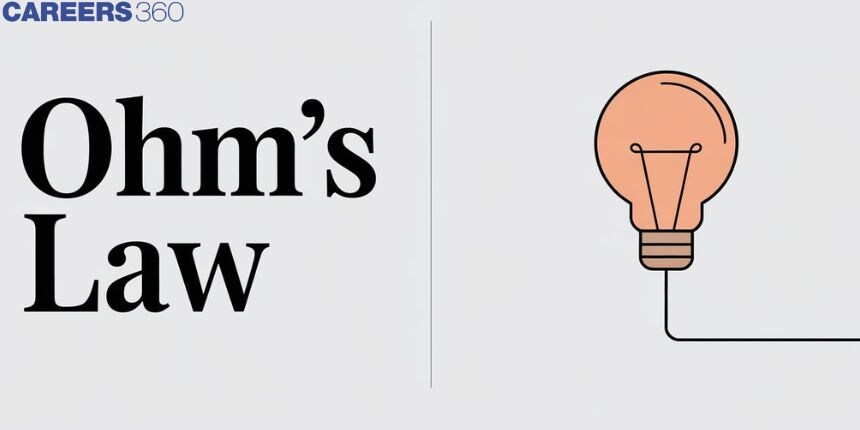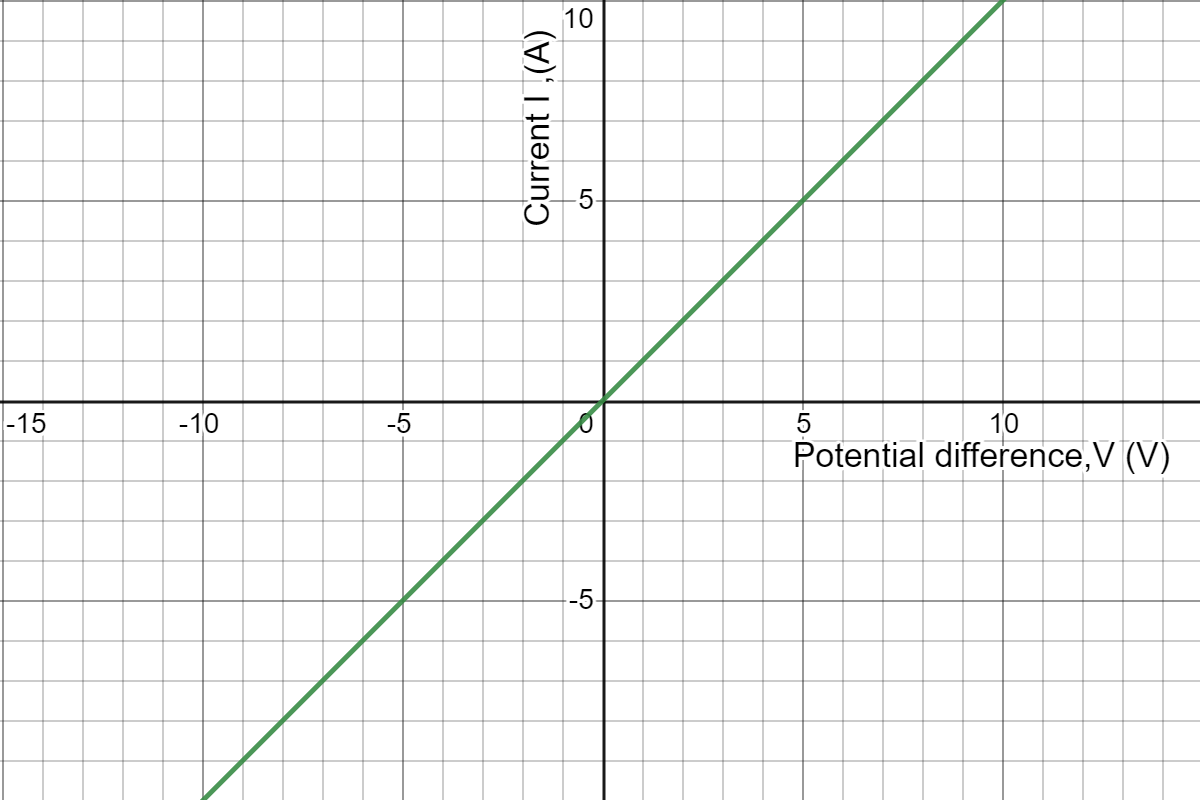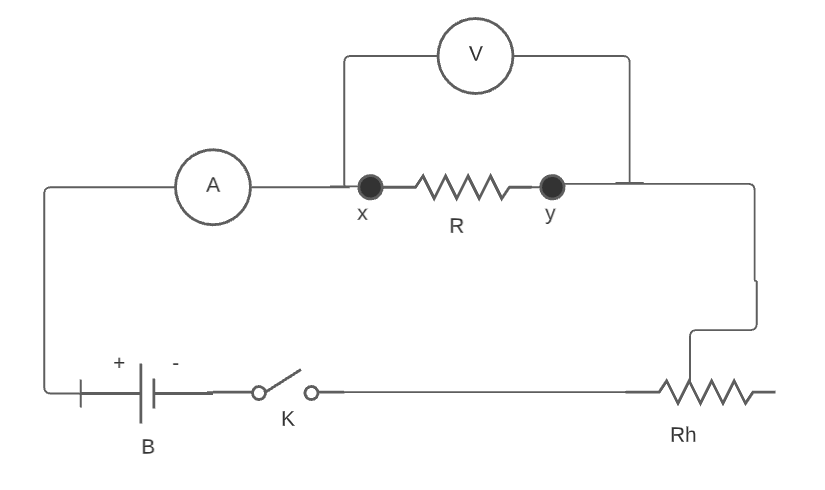Ohm's Law - Definition, Formula, Applications, FAQs
What is ohm’s law Class 10?
Georg Simon Ohm, a German physicist, invented Ohms law, which describes the relationship between potential difference and current.
Ohm’s law statement: According to Ohms law, the steady current I flowing through a conductor is proportional to the potential difference V between the conductor's two ends at a constant temperature. The link between an electric current and the potential difference is defined by Ohms law.
The formula of ohm’s law, V=IR
Ohm’s law is the most fundamental law in electricity.
JEE Main/NEET 2027: Physics Important Formulas for Class 10
NEET 2025: Mock Test Series | Syllabus | High Scoring Topics | PYQs
JEE Main: Study Materials | High Scoring Topics | Preparation Guide
JEE Main: Syllabus | Sample Papers | Mock Tests | PYQs
- What is ohm’s law Class 10?
- Definition:
- Applications of Ohm’s law:
- Uses of Ohm’s law:

Derivation of ohm’s law
An electric current flowing through a conductor is precisely proportionate to the difference in potential between the conductor's two ends, according to ohm’s law.
I proportional to V
Hence, IV=constant
The value of this constant proportionality constant is found to be 1/R
Therefore, I=V/R
V=IR
Here, R is a constant for a given material at a given temperature which is known as the resistance of the material. Since the potential difference V is proportional to the current I, the graph between Vand I is a straight line for a conductor.
Ohmic conductor graph:

Definition:
Electric circuit:
A closed conducting loop or path with a network of electrical components through which electrons can flow is known as an electric circuit. This loop is made using the electrical wires which is to connect an electric appliance to a source of the electric charges like a battery. An electric circuit must be closed in order that the current passes through it.
Electric current:
Current is defined as the rate at which charges flow through a conductor, implying that the electric current represents the number of charges flowing through any cross-section of a conductor in a given amount of time. The letter I stands for current. If a net charge Q travels through any cross-section of a conductor in time t, the current flowing through it is
\mathrm{I}=\mathrm{Q} / \mathrm{t}
The ampere is the SI unit of electric current and is represented by the letter. When a charge of coulomb runs over any cross-section of a conductor in one second, the current flowing through it is said to be one ampere.
1 ampere=1 coulomb/1 second
When a conducting path is given to a charged object, electrons begin to flow through the path from a higher to a lower potential state. The potential difference can be produced by using a cell or battery. A current of electricity is generated as electrons move. Therefore, an electric current is produced by the moving electrons.
An ammeter is a device that is used to determine the strength of an electric current in a circuit. In a circuit where the current is to be found, the ammeter is connected in series.
|
Related Topics, |
Potential difference:
The amount of labour involved in transporting against the electric force, a unit counter electrode from one position to another is described as the electric potential difference between two points. The potential difference required for the flow of charges can be provided by the battery. From the negative electrode to the positive electrode, electrons flow. The letter V denotes the possibility of a difference.
V=work done (w)/charge (Q)
The volt is the SI unit for electric potential difference and is symbolised by V. The potential difference between two points is one volt if one joule of labour is expended in moving one coulomb of charge from one point to another against the electric force.
1 volt=1 joule/1 coulomb
Joule is a unit of measurement for the quantity of electrical energy transferred into other forms of energy and the amount of charge is measured in coulomb.
A voltmeter is a tool that measures the difference in potential between two ends. The voltmeter must always be connected in parallel to a component in a circuit to evaluate the potential difference across it.
Resistance:
The property of a substance to oppose the flow of charges and thus the passage of current through it is known as resistance. The ratio of the potential difference between the conductor's ends to the current flowing through it is the conductor's resistance. The letter R stands for resistance.
$\mathrm{R}=\mathrm{V} * \mathrm{I}$
The ohm is the SI unit of resistance and is represented by the symbol. When a conductor carries a one-ampere current and a one-volt potential difference is maintained across its ends, the resistance is said to be one ohm.
1ohm=1 volt/1 ampere
With the help of the resistance, we can regulate the quantity of current flowing in a circuit. When the flow of current is obstructed, heat is generated. This is because electrons encounter resistance as they move along a wire. To overcome the opposition that has been converted into heat energy, work must be done. This conversion of electrical energy into heat energy is called Joule heating. The components used for providing resistance are called resistors.
The measure of resistance given by a component to the flow of electric current through it is called resistance. Different electrical components offer different electrical resistance. Metals such as copper, aluminium etc. offers negligible resistance to the electric current. These are good conductors. The materials like Nichrome, tin oxide etc. provide a high level of resistance to electric current.
Ohm’s Law for Power:
Power is the rate of consuming electrical energy and is defined as the rate of accomplishing work or spending energy. It determines how efficiently electrical energy is transferred into another form of energy.
If a current streams through a conductor with resistance for a period, the potential difference between the conductor's two ends is. The equation gives the work done to transfer the charge across the ends of the conductor.
W=VIt
P=VIt/t
P=VI
Also read -
- NCERT Solutions for Class 11 Physics
- NCERT Solutions for Class 12 Physics
- NCERT Solutions for All Subjects
Applications of Ohm’s law:
At constant temperature, ohm’s law can be applicable. Electricity's fundamental law is Ohm’s law. The applications of Ohm’s law are,
- In an electric circuit, the current, potential difference and resistance can be determined.
- The power efficiency of an electric circuit can be calculated.
- Ohm’s law is applicable to the linear elements
Failures of Ohm’s law:
- The behaviour of devices such as diodes and transistors is not explained by Ohm’s law.
- Ohm’s law does not give the expected result at the variable temperature.
- Ohm’s law cannot be applicable to non-linear elements.
NCERT Physics Notes:
Uses of Ohm’s law:
- We may control the speed of the fans in our residences by pushing the regulator back and forth.
- The current going through the fan is regulated here by regulating the resistance via the regulator.
- Using Ohm’s law, we can determine the resistance, current, and consequently power flowing for any given input value.
Experimental verification of Ohm’s law circuit diagram:
A parallel connection is made between a voltmeter and a resistor. An ammeter is interfaced to measure the current in the circuit. A variable resistor is connected to the circuit. Changing the resistance changes the potential drop across the resistor, affecting the amount of current flowing through it. We can deduct from the reading that current and potential vary linearly.

A Nichrome wire is connected between X and Y. When you use a copper wire rather than just a Nichrome wire in the same experiment, you'll need a different current for the same potential difference across the wire. If you replace the copper wire with an aluminium wire, the current running through it will have a different value. From the equation V=IR, you have learnt that VI must be equal to the resistance of the conductor used. The variations in the current for the same values of potential difference indicate that the resistance of different materials is different.
Ohm’s law for the magnetic circuit:
In a magnetic field, the magnetomotive force is proportional to the product of the number of turns around the core in which the flux can be produced and the current through the turns of the wire.
Fm=NI
Where,
Fm- Magnetomotive force
N – Number of turns around the core
I – Current flows through the turns of the wire.
Also Read:
- NCERT Solutions for Class 12 Physics Chapter 3 Current Electricity
- NCERT Exemplar Class 12 Physics Solutions Chapter 3 Current Electricity
- NCERT notes Class 12 Physics Chapter 3 Current Electricity
Numericals on Ohm’s law
1. A 12-clombs charge passes through a bulb in 5 seconds. How much current passes through the bulb?
Solution:
Charge, Q=12 C
Time,t=5 s
To find the current:
I=Q/t
I=12/5
I=2.4 A
Hence, the current flows through the bulb is 2.4 A
2. Moving a charge of 10 C across two locations in a circuit requires 100 J of labour. What could be the difference between the two points?
Solution:
Charge, Q=10 C
Work done, W=100 J
To get the possible difference between the points, do the following:
V=work done (w)/charge (Q)
V=100/10
V=10 Volt
Hence, the potential difference between the two points is 10 Volt.
3. Calculate the resistance of a conductor with a 2 A current and a 30 V potential difference between its ends.
Solution:
Current through the conductor, I=2 A
The potential difference between its ends, V=30 V
From Ohm’s law,
R=V/I
R=30/2
R=15 Ω
Hence, the resistance of the conductor is 15 Ω
4. A lamp of resistance 70 Ω draws a current of 0.75 A . Find the voltage
Solution:
Resistance, R=70 Ω
Current, I=0.75 A
To find the voltage:
From Ohm’s law,
V=IR
V=0.75(70)
V=52.5 V
Hence, the voltage of a lamp is 52.5 V
5. A bulb with a resistance of 400 ohms is connected to a 220 V power supply. Calculate the magnitude of the current
Solution:
Resistance, R=400 Ω
The potential difference, V=220 V
To find the magnitude of the current:
From Ohm’s law,
V=IR
I=V/R
I=220/400
I=0.55 A
Hence, the magnitude of the current is 0.55 A
6. When the potential across the filament of a bulb is 100 V, the current through it is found to be 2 A. Find the resistance of the filament.
Solution:
The potential across the filament, V=100 V
The flow of current, I=2 A
To find the resistance of the filament:
From Ohm’s law,
V=IR
R=V/I
R=100/2
R=50 Ω
Hence, the resistance of the filament is 50 Ω
7. A resistance of 15 Ω carries a current of 5 A. Calculate the voltage that has built up across the resistor.
Solution:
Resistance, R=15 Ω
Current, I=5 A
To find the voltage developed across the resistor:
From ohm’s law,
V=IR
V=(5)(15)
V=75 V
Hence, the voltage across the resistor is 75 V
8. A lamp draws a current of 0.91 A with a potential difference of 110 V. What is the resistance in the lamp?
Solution:
Current, I=0.91 A
The potential difference, V=110 V
To find the resistance in the lamp:
From ohm’s law,
V=IR
R=V/I
R=110/0.91
R=121 Ω
Hence, the resistance in the lamp is 121 Ω
Also check-
Frequently Asked Questions (FAQs)
According to Ohm’s law, the steady current I flowing through a conductor is proportional to the potential difference V between the conductor's two ends at constant temperature..The link between an electric current and the potential difference is defined by Ohm’s law.
Formula of ohm’s law, V=IR
At constant temperature, ohm’s law can be applicable. Electricity's fundamental law is Ohm’s law. The applications of ohm’s law are,
In an electric circuit, the current, potential difference and resistance can be determined.
The power efficiency of an electric circuit can be calculated.
Ohm’s law is applicable to the linear elements
We may control the speed of the fans in our residences by pushing the regulator back and forth.
The current going through the fan is regulated here by regulating the resistance via the regulator.
Using Ohm’s law, we can determine the resistance, current, and consequently power flowing for any given input value.
Also Read
29 Nov'24 09:48 AM
23 Nov'24 01:56 PM
20 Nov'24 10:32 AM
17 Nov'24 10:02 AM
17 Nov'24 09:56 AM
14 Nov'24 07:31 PM
14 Nov'24 05:59 PM
14 Nov'24 01:16 PM
14 Nov'24 12:54 PM